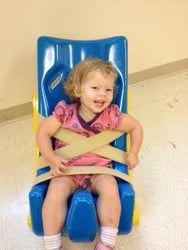Tumble Forms Seat in the Hospital
Jump to:
| Goal for: __________________________________________________________________(name). The goal is to be up in the seat ________ times per day for ________ minutes each time. Start on: (date). Start with _______ times per day for _________ |
What is a Tumble Forms seat?
A Tumble Forms seat helps your child sit upright at different angles with full body support. The seats are used for children six months old and older. Tumble formWhy should my child use this chair? 
The seat helps your child sit up instead of lying in bed. It also helps your child:
- See and interact with family and staff.
- Breathe better.
- Play with toys in a seated position.
- Eat while sitting up and supported.
Safety
- A responsible adult should be with your child at all times while they are in the seat.
- Always put Tumble Forms on a flat surface.
- Crib: The crib bed should be flat and rails must be up to highest level.
- Bed: The bed should be flat and bed rails must be up. Support the seat with pillows as needed to prevent tipping over.
- Do not use the chair in the bathtub or shower.
- Always strap your child in the seat. Use the soft straps either across the lap and chest or crisscrossed over the chest. Keep the straps away from the neck.
- Your child’s head must be touching the back of the seat.
- If your child’s head falls forward, move the seat angle on the wedge to a less upright position.
- Use small rolled up blankets on each side of the head to keep head in the middle if needed.
Cleaning
If the seat gets dirty, use Sani-Cloth wipes with gloves. Soap and warm water can also be used. If the straps get dirty, ask your nurse or therapist for new ones.



